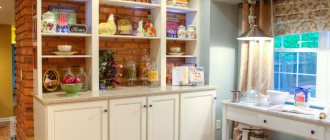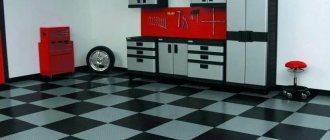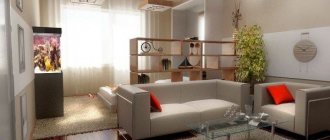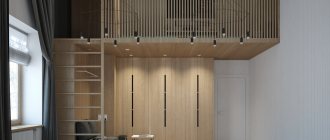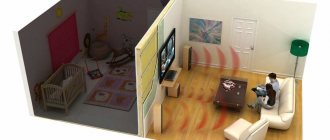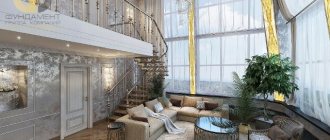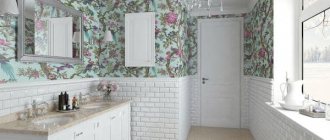How to choose a lampshade for your favorite interior
How to choose a lampshade (pendant, wall, floor or table lamp) that fits perfectly into the design and emphasizes stylish luxury or elegant simplicity?
The influence of lighting on daily life and a person’s psychological state is a popular topic for study and discussion. Of course, this category is extensive and is supplemented every day with new projects and ideas, so it will appear on the pages of our website more than once.
This article is only a small part of it and invites you to listen to practical advice.
Color accents for room decoration
When choosing a look and shape, many try to maintain the unity of style and color scheme. If the interior lacks brightness and character, listen to the advice of designers and take a closer look at the bold configurations and rich shades of the lampshade, which will not only differ from the rest of the decorative elements, but will also become the center of the entire composition.
If you want to add a new item, opt for a neutral palette.
The main task of a good lamp is to perform its functions correctly
ADDITIONAL FUNCTIONS
Modern manufacturers do not stop only at achieving an attractive appearance of floor lamps, producing original models. They try to provide the model with the most convenient functionality possible.
- The lighting control is the simplest, but certainly convenient and necessary function. With a small mechanism, you can turn the brightness to maximum or create an intimate setting by turning it down to minimum. Thus, with just one lamp, the atmosphere in the room can change depending on the needs.
- A grandfather clock, in the form of which the main part of the leg is made, will not only free you from the need to specially allocate free space on the wall for a clock, but will also fit well into a classic interior. Especially if they are made of wood with carved elements.
- A floor lamp with a shelf located near the bed will perfectly replace a bedside table. There are models with several shelves on which you can conveniently place your favorite book, remote control, glasses and other small items.
- A coffee table with a floor lamp on one of the corners will be indispensable next to the chair in which you like to read or drink coffee. There’s probably no need to talk about its convenience.
- The control panel built into the leg will save you from the need to get out of bed in order to turn the floor lamp on or off. This is also a very convenient and necessary function.
Of course, models equipped with such amenities are more expensive, but this is a highly controversial issue. After all, buying a table and floor lamp separately is often more expensive than buying a combined item.
The ideal lamp, or a single whole
When looking for a chandelier, floor lamp or sconce in a shopping center, we pay special attention to the design of the lampshade, but this is not the only significant detail: in addition to a beautiful lampshade, there is also a base that provides stability and is responsible for fastening.
Unfortunately, this element does not always look aesthetically pleasing, so do not forget to evaluate the design completely, “from head to toe.” Both the base and the cap should complement each other. You also need to take into account that the “correct” lampshade masks fastening elements or supports without compromising functionality. This is especially true for table lamps.
Features of the generated light flux
An important criterion when choosing a lampshade for a table lamp is how it transforms the light it creates. This is the most important functional characteristic of any lampshade, on which the convenience and efficiency of using the lamp depend.
First of all, you need to decide on the appropriate light transmittance - the higher it is, the less the lampshade affects the luminous flux. The following categories of light transmission can be distinguished:
- Maximum - it is typical for lampshades made of simple glass. In this case, the light from the bulb enters the room unchanged, so it is recommended to use such lampshades in interior lamps that create atmospheric lighting and support the central chandelier.
- Dimming - in this case, the light passing through the lampshade material becomes less intense. Thin and light fabrics can have this effect. You can use dim light to create comfortable conditions in the recreation area, bedroom, etc.
- Diffusing - here, thanks to the correctly selected shape and materials of the lampshade, the flow of light created by the light bulb is effectively dispersed in space. It can be used for decorative purposes to give a particular mood to the interior; it is also suitable for evening lighting, since soft, diffused light in space will help the body tune in to a night's rest.
- Reflective - light rays do not pass through the lampshade, but are reflected by a special coating. This technique allows you to obtain directional lighting, which is used in table lamps for work tables and desks.
The direction in which the light is distributed also plays a big role. Classic lampshade models are open at the bottom and top. Moreover, the main flow of light comes out through the lower part, and the upper hole helps create additional interior lighting. In some cases, the lampshade can be opened upward, in which case a spectacular reflected illumination is created in the room.
To equip a workplace, desk or hobby corner, as a rule, lamps with shades that create a narrowly directed light flux are more suitable. In this case, you will simultaneously provide comfortable conditions for your activities and reduce eye strain, since the light beam created by the lamp will not blind you.
If you plan to use a table lamp for reading, you can choose a wider shade, which will diffuse the light somewhat into the space, creating a softer and more comfortable atmosphere.
Lampshade A21002 fabric+PVC film E14X 40W Peonies
To create comfortable decorative lighting in living rooms, bedrooms and other similar interiors, it is recommended to choose diffusers that evenly distribute light throughout the entire area. These can be monochrome fabric models that create a uniform glow around them. Additionally, refractive or reflective effects will help soften it and disperse it in the room.
Separate requirements for lampshades of table lamps used as nightlights. The light they create should be both bright enough for you and not disturb the sleep of another person sleeping next to you. Therefore, for such a lamp, it is recommended to choose a diffuser made of dense fabric, which effectively dims the glow of the light bulb, making it non-intense and non-directional.
We evaluate the sizes and choose the color scheme
Almost all designers’ recommendations boil down to one thing: proportions must be respected in any interior. For example, in a small room, bulky objects are unacceptable, depriving the owners of free space and blocking the flow of light and air. And, conversely, in a spacious room with high ceilings, small figures will look ridiculous.
Before choosing a lamp, find a place for it. Then focus on shape, size and color scheme.
Bright accents in the form of yellow sconces and a floor lamp for a stylish interior
THE CONCEPT OF “FLORCHER” AND THE ADVANTAGES OF ITS USE
This is a floor lamp on a small base with a high leg that ends with a lampshade. Lampshades come in cylindrical, conical, spherical or custom shapes and can be made from a variety of materials. The leg can have different heights and diameters. The entire set of floor lamps, regardless of the material of manufacture, can be divided into two large groups:
- A decorative floor lamp is designed to create dim illumination and has a low luminous flux power, thanks to which it creates a pleasant atmosphere that sets the mood for relaxation. Very often, the lampshades and legs of such floor lamps have original shapes in the form of flowers, torches, and street lamps.
- A functional floor lamp provides high-quality, complete lighting of almost the entire room. Such lamps are sometimes used instead of an overhead light source. With sufficient power, they can easily provide the required level of lighting in the workplace. They often have the ability to adjust the angle of inclination and rotation of the lampshade and a telescopic, inclined leg.
The advantages of this lighting device over other types of lamps are obvious:
- They do not require any type of installation. The purchased model is already ready for use, all that remains is to figure out a place for it and ensure the presence of an outlet.
- At any time you can change its location or remove it altogether thanks to its mobility.
- Thanks to the floor-standing installation method, you don't need to take up extra space on your coffee table or buy a special cabinet to accommodate it, and you don't risk scratching the polished or glass finish.
- It is floor lamps that create a unique atmosphere of comfort in your home and decorate the overall interior with their appearance.
Create a sunny mood
Everyone knows that the main function of a lampshade is to softly diffuse direct rays and direct local lighting. But few people have thought about the fact that the color and shape of an accessory can affect our mood.
For example, if you want to feel like you have a bright and open personality, buy a model that will provide maximum illumination. Remember that the desired effect is achieved faster in a snow-white space. If you want to create a calming atmosphere that gives you a feeling of security, consider tinted lampshades.
In recent years, original floor lamps have been very popular, casting bizarre, sometimes even gradient shadows in the form of geometric patterns, graceful trees, fantastic flowers... Figured outlines radically change the mood and force you to perceive space differently.
Classics of the genre: comfort with tassels
A lampshade made of fabric: matting, canvas, chintz or linen will create a special coziness in your home or dacha.
It's easy to sew. A strip of the required width is cut out from suitable material and sewn on both edges. Then the material is gathered into a ring, a cord is pulled into the upper drawstring and pulled together so that the lampshade forms dense gathers. The resulting product is placed on a frame, which will retain a beautiful rounded shape.
You can search for options on how to make a frame for a lampshade in various Internet sources. The easiest way is to use thick wire rolled into a ring. You will need two or three of these blanks of different sizes. The smallest ring is attached to the top, the middle one is glued in the center, the bottom ring should be the largest. The finished product in the lower part can be decorated with fringe. It is also appropriate to decorate a fabric lampshade with bows, embroidery, beads or sequins. The choice of decor depends on the style of the room.
A lampshade for a floor lamp made independently will be inexpensive, and its appearance can be quite decent. This product will be an excellent gift; you can involve children in making it; they will really like this leisure option. Even kids can create a lampshade for a floor lamp with their own hands; this work will be a source of pride and a real decoration for a child’s room.
In the same style
Ceiling chandeliers remain the most popular type of suspended structures to this day. Having come a long way since their inception, suspended structures have undergone significant metamorphoses, changing not only the material from which they were made, but also their shape. Many retro configurations are returning to modern times, becoming the main concept of room design.
When choosing a lampshade, even without outside advice, we strive to find an option that will harmonize with the overall style of the house. A wide selection of chandeliers from numerous manufacturers makes this easy to do.
The perfect lampshade reflects the style and mood of the interior
Step-by-step instructions for wireframe view
It’s not difficult to make a lampshade on a frame with your own hands. You just need to adhere to step-by-step technologies for doing the work.
Step 1. Preparation, selection, schemes
First you need to choose which option to use. When choosing, personal tastes, ease of operation and interior style should be taken into account. For example, paper is not entirely suitable for a classic style, but burnt wood is for hi-tech.
Also at the first stage you need to draw up a diagram of the frame. All elements and dimensions should be indicated on it.
Popular patterns for table lamps.
Step 2. Making the frame
Method of fixing the wire.
According to the previously prepared diagram, the wire of the required size is cut. The simplest option is two rings, where the smaller one is installed in the upper part, and the larger one in the lower part, they are fastened together with straight pieces of wire. If you need a more interesting shape, then you can even make three or four wheels. The elements are fastened with hook-shaped bends.
Step 3: Stretching the finishing material
One of the most popular materials is textiles. But first you need to build a blank from cardboard, which is used to wrap a wire frame, and the product is cut to the desired shape. The resulting blank is laid out on the fabric, and it is cut out along its contour. When the desired piece of fabric is cut out, you can turn the edge over and stitch it with a sewing machine.
Stitching the edges.
Step 4: Finishing the Edges
If it was not possible to process the edge on a sewing machine, the wire frame is covered with fabric. Everything is fixed with glue. The edge is also folded over and glued to the inside.
Step 5. Decor
You can paint the finished product in different colors, glue cardboard or wooden figures to the inside, and make drawings.
Lampshades in non-residential premises look elegant
A modern approach to home decoration requires attention to every detail. The design of a bathroom, dressing room, corridor, laundry room is subject to no less stringent requirements than the main rooms, so you need to choose lamps for them no less carefully.
It should be noted that simple configurations look impressive and elegant, such as in the project in the photo below.
Elegant lampshade for a stylish bathroom
Which one should I do?
Rack-mounted table lamps (item 1 in the next figure) illuminate a work area that does not require rapid movement of the light spot across the surface of the table: dressing table, desk. The possibilities for decorative design in this case are greatest. Technically, the design of a table lamp on a stand is the simplest. There are practically no possibilities for quickly adjusting the size of the illuminated area. Adjusting the illumination of the working area is possible if there is a thyristor voltage regulator in the lamp, but the spectrum of the emitted light changes significantly.
Types of table lamps
A huge advantage of rack-mounted table lamps is the ability to obtain so-called lamps using relatively simple means. cosecant-square radiation pattern (DP) of the illuminator, see also at the end. A cosecant square pattern provides almost uniform illumination of the working area within a certain angle φ (see figure on the right), which sharply reduces fatigue from intense intellectual work.
Cosecant-square radiation pattern of the illuminator
Lamps on a breakable hinged bracket (item 2) are more suitable for technical creativity. Lamps on a pantograph bracket at home are impractical and technologically complex, and making a lamp on a flexible bracket at home will cost more than buying a ready-made one.
The design of a table lamp on a breakable bracket is limited to laconic and utilitarian forms. The design is more complex than that of a lamp on a stand, primarily due to the requirement for electrical safety, see below. The possibilities for quickly adjusting the light in the work area are wide both in terms of the size of the illuminated area and its illumination with a constant spectrum.
Console table lamps (item 3) are less common in everyday life, because for stability they require a heavy base and, most often, a counterweight, which complicates and increases the cost of the design. There are fewer possibilities for quickly adjusting the light in the work area for console lamps than for lamps on brackets, but it is possible to obtain a cosecant square pattern.
Table lamps without raising the light source above the supporting surface are no longer table lamps, but night lights (item 4). The fundamental difference between both is that the night light does not have a working area with certain light requirements. Accordingly, the light from a night light can be whatever you want, as long as it doesn’t harm your health.
The embodiment of the style and taste of the home owners
Everyone knows that the decoration of a house is an expression of the inner “I” of its owner. But this does not mean that you need to limit yourself in expressing yourself in detail. You can decorate the space with paintings, vases, figurines and cute personal touches. But why not try yourself as a designer and create a lampshade for your living room yourself? Objects familiar to the eye can help.
Useful and free advice: look around. What materials, textures and colors surround you? If you decide to boldly declare yourself, choose an option that is strikingly different from them. Do you want to emphasize restraint and elegance? Give preference to neutral shades and classic textures.
Floral pattern of textile lampshade as an elegant decor for a stylish living room
How to build a frame
Read our instructions or watch a video master class on how to make a beautiful lampshade and get to work. If you can’t find an old frame, make your own - round or diamond-shaped. They are the most interesting and easiest to “dress.”
Draw it on paper, maybe life-size, determine the total length. Using the school formula, determine the circumference of a circle using two radii multiplied by 3.14. Add the length of several spacers. And at the point where they converge towards the center, solder a ring, which will become a mount for the lamp socket.
For the lampshade you will need two such fasteners - at the top and at the bottom; you solder them with the same wire. There are two round ones of the same size, a conical one - each with its own perimeter: the larger one at the bottom, because the light should fall through a spacious area. And get the right frame for the lampshade with your own hands.
Fitting the form into the surrounding space
The geometry of objects plays an important role in creating a harmonious, integral and complete image. When choosing a lamp for a room, pay attention to its shape.
Today, manufacturers offer a wide range of lampshades: balls, cylinders, drums, bells, polyhedrons will help create the necessary atmosphere. Remember that shape affects not only aesthetics, but also the degree of illumination of the space and the visual effects of light and shadow. An ideal lampshade will satisfy all of the above parameters.
The shape of the lamp as an important parameter when decorating a room
Decoration of fabric structures
The simplest ones are plain fabric lampshades. But there are additional decoration possibilities.
Provencal style
It is distinguished by the use of pastel colors, checkered patterns, and lace. For decoration, you can cut a strip of fabric, which is wrapped around the upper part and additionally tied in a bow. Another strip can be wrapped around the bottom and fringe attached to it.
Fabric flowers
You can make small fabric flowers that decorate the bottom of the lampshade in a circle. If you have the desire and patience, you can cover the entire body of the product with flowers.
Product decor with fabric flowers.
Shreds
Using pieces of different fabrics provides an interesting result. You need to take a plain, preferably white fabric for the base, and sew the scraps onto it. They can be in the form of squares, horizontal, vertical or diagonal stripes. Non-standard geometric shapes can also be used.
Decoration with pieces of different fabrics.
Unusual materials
The decor of the lampshade is limited only by the imagination of the master. You can use different fabrics for the lampshade: burlap, jeans, lace napkins. Additionally, you can decorate the surface with sewn buttons, pockets, and bows.
Fan grille
Many of us have once used a fan that has already become unusable. However, such a device has a useful element - a grid. It is usually present in all floor-mounted fans. So why not give it a second life?
In addition, a certain shape already exists - a kind of spherical segment. However, if desired, the frame can be deepened by securing an additional tier of the same wire at the bottom. Or, as another option, lining it with some material. Both will be quite appropriate.
Living room
Chandeliers in the living room interior are selected with special attention, because the needs of each family member must be taken into account. In addition, the design of lamps in the interior can become a key decorative element that will attract the attention of guests.
In every home, the living room performs many functions: it is a place for relaxation, children's games, watching TV, conversations and negotiations, it can also be a workplace, a home banquet is also held here.
If this is a studio apartment, then the living room will be the key area. It is important to decide on the design of the room, the number of lighting fixtures, their intensity and the location of the central chandelier.
In the photo, the original pendant chandelier looks discreet and laconic, performs the main function and fits the design of a living room in a modern style.
Kitchen
Chandeliers in the kitchen interior add coziness and create a family atmosphere. It is best to choose small lamps mounted near the ceiling with a simple design, this will facilitate maintenance and emphasize its practicality.
In the photo, a crystal chandelier and a glass table create a single dining area. The unusual placement of the lamp attracts attention and makes the kitchen original.
The lamp can complement the interior or stand out with an unusual design. It can be placed in the center, or above the dining table. Don’t forget about additional lighting above the work surface; additional lamps should not conflict with the chandelier.
Security requirements
DIY lampshades must comply with fire safety standards
The lampshade is in direct contact with the lighting fixtures and is exposed to high temperatures. Therefore, when making it yourself, it is necessary to take into account fire safety rules:
- the base is attached at a distance from the lamp determined by the power of the device - at least 7–10 cm
- Flammable materials should not come into contact with the light bulb: fabric, plastic, threads, cardboard, paper, wood products
- choose lampshades made of ceramics rather than plastic, since the latter do not dissipate heat well
- It is forbidden to use an incandescent lamp
In a safe lamp:
- Fluorescent or LED lamps are used
- The materials for creating the base and frame are heat-resistant and do not emit toxic substances when heated
- A light bulb with a bright glow, but low power is used
- The internal walls do not heat up 15 minutes after connecting the device to the power supply.
